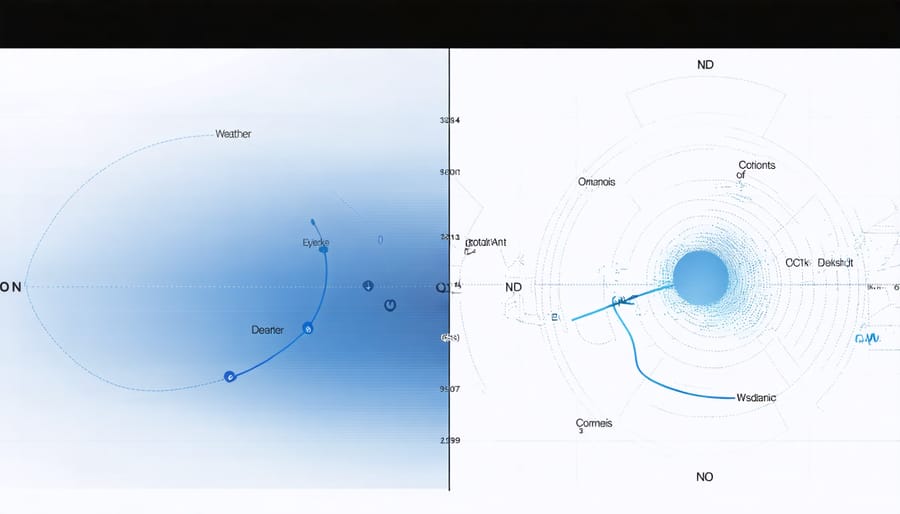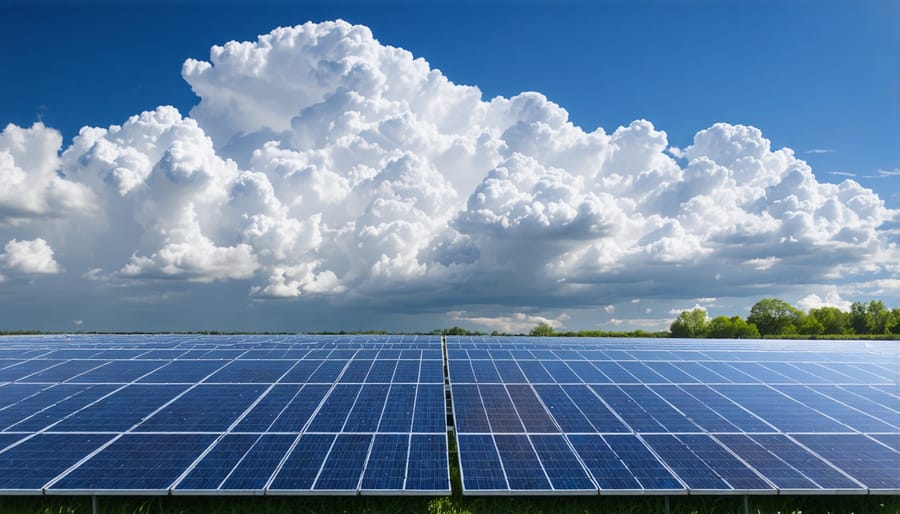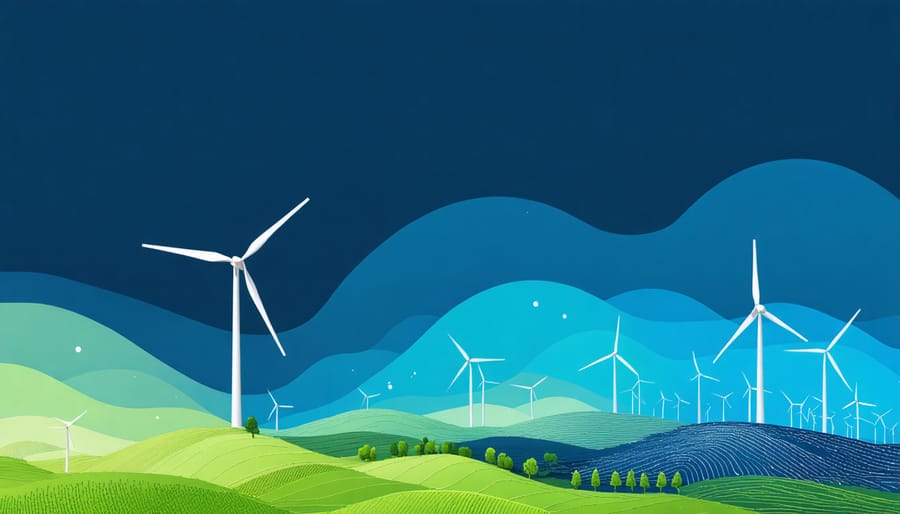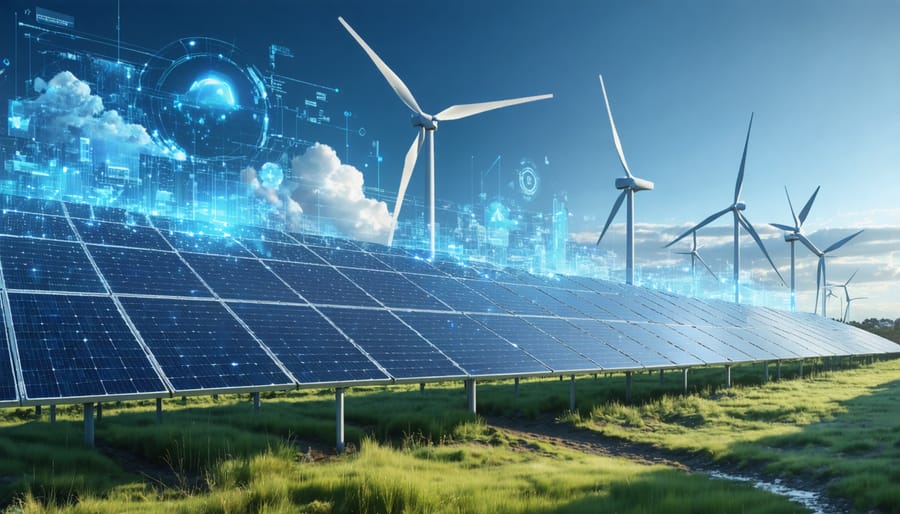Artificial intelligence is revolutionizing the way we predict and manage renewable energy systems across Australia. By analyzing vast amounts of weather data, satellite imagery, and historical performance metrics in real-time, AI forecasting systems are achieving unprecedented accuracy in predicting solar and wind power generation. These advanced algorithms now deliver predictions up to 45% more accurate than traditional forecasting methods, enabling grid operators to optimize energy distribution and storage with remarkable precision.
For the renewable energy sector, this technological breakthrough couldn’t have come at a more crucial time. As Australia pushes toward its ambitious goal of 82% renewable electricity by 2030, AI forecasting has emerged as a vital tool for managing the intermittent nature of renewable resources. From the sprawling solar farms of Queensland to the wind turbines dotting South Australia’s coastline, these intelligent systems are helping operators maximize clean energy output while maintaining grid stability.
The impact extends beyond just improved accuracy – AI forecasting is transforming how we integrate renewable energy into our power grids, reducing costs, minimizing waste, and accelerating Australia’s transition to a sustainable energy future. By combining machine learning with local weather patterns and historical data, these systems are creating a smarter, more reliable renewable energy network for tomorrow.
How AI Transforms Weather Predictions for Renewable Energy
Machine Learning vs Traditional Forecasting
While traditional forecasting methods rely on historical data and static mathematical models, AI weather forecasting represents a quantum leap in prediction accuracy. Traditional approaches often struggle with complex weather patterns and rapid changes, typically achieving accuracy rates of 60-70% for day-ahead forecasts. In contrast, machine learning systems can process vast amounts of real-time data, satellite imagery, and local sensor information to deliver accuracy rates exceeding 90% in many cases.
The key advantage lies in AI’s ability to adapt and learn from new data continuously. While conventional methods might take weeks to adjust their models, AI systems can update their predictions in real-time, making them particularly valuable for Australia’s diverse climate zones. This dynamic learning capability has proven especially effective in predicting sudden weather changes that affect renewable energy generation, such as cloud cover for solar farms or wind pattern shifts for turbines.
For renewable energy operators, this improved accuracy translates to better grid integration and more efficient power management, ultimately leading to more reliable and cost-effective clean energy solutions.

Real-time Data Processing Capabilities
Modern AI systems excel at processing and analyzing massive amounts of real-time data from diverse sources, making AI-powered renewable energy predictions more accurate than ever before. These sophisticated systems simultaneously monitor satellite imagery, weather stations, atmospheric sensors, and historical climate patterns, processing this information in milliseconds to generate precise forecasts.
Think of it as having thousands of expert meteorologists working around the clock, but at lightning speed and with perfect memory. The AI can detect subtle patterns in cloud movements, analyze wind direction changes at multiple altitudes, and track temperature fluctuations across vast regions simultaneously. This real-time processing capability is particularly valuable in Australia’s diverse climate zones, where weather conditions can change rapidly.
What makes these systems truly remarkable is their ability to learn and adapt. Each new data point improves the accuracy of future predictions, creating a continuously evolving forecasting model that becomes more reliable over time. For renewable energy operators, this means having access to up-to-the-minute forecasts that help optimize energy generation and storage strategies, ultimately leading to more efficient and reliable renewable power systems.
Solar Power Forecasting Breakthroughs
Cloud Coverage Analysis
Artificial Intelligence has revolutionized how we predict cloud coverage, making solar energy generation more reliable and efficient than ever before. By analyzing satellite imagery and weather data in real-time, AI algorithms can now forecast cloud movements with remarkable accuracy up to six hours in advance.
These smart systems process multiple data layers, including cloud density, speed, and direction, while considering local weather patterns unique to different Australian regions. For instance, in coastal areas like Sydney, AI models account for morning sea breezes that often bring cloud cover, helping solar farm operators adjust their operations accordingly.
The technology employs deep learning networks that continuously improve their accuracy by learning from historical patterns. When a system notices approaching cloud coverage, it can automatically alert grid operators to prepare alternative power sources, ensuring stable energy supply. This predictive capability has proven particularly valuable in Queensland’s solar farms, where afternoon thunderstorms can rapidly affect solar generation.
Modern AI systems can even distinguish between different cloud types and their impact on solar radiation. Light, wispy cirrus clouds might reduce generation by 20%, while dense cumulonimbus clouds can drop output by up to 90%. This granular understanding helps power companies optimize their grid management and storage solutions.
The real game-changer is the integration of these predictions with automated control systems. When AI forecasts significant cloud cover, it can trigger automated adjustments in solar panel positioning or activate battery storage systems, maximizing energy capture during clear periods and ensuring smooth power delivery during cloudy conditions.

Panel Performance Optimization
Artificial Intelligence is revolutionizing how we maximize solar panel performance, turning vast amounts of weather and production data into actionable insights. Modern AI systems can predict solar panel output with remarkable accuracy, often up to 48 hours in advance, by analyzing multiple data streams including satellite imagery, local weather patterns, and historical performance metrics.
In Australia, where solar adoption continues to surge, AI-powered systems are helping homeowners and large-scale solar farms optimize their energy production. These smart systems can detect when panels are underperforming due to dust accumulation, shade interference, or technical issues, triggering maintenance alerts before significant output losses occur.
For example, the Solar Analytics platform used across Australian solar installations employs machine learning algorithms to compare actual panel performance against expected output. This technology has helped users increase their solar yield by up to 15% through timely maintenance and operational adjustments.
AI systems also excel at micro-forecasting, predicting cloud cover and its impact on specific solar installations with unprecedented accuracy. This capability allows grid operators to better manage energy distribution and helps solar farm owners optimize their storage solutions. In Queensland’s solar belt, AI-driven forecasting has reduced production uncertainty by 30%, leading to more efficient grid integration and improved returns on investment.
The integration of AI into solar monitoring systems represents a significant step forward in making renewable energy more reliable and cost-effective, helping Australia move closer to its clean energy goals.
Wind Power Prediction Advancements
Wind Pattern Recognition
In the dynamic world of wind energy, AI systems are revolutionising how we understand and predict wind patterns, making turbine operations more efficient than ever before. These intelligent systems analyse vast amounts of data from multiple sources, including weather stations, satellite imagery, and historical wind records, to create highly accurate forecasting models.
Modern AI algorithms can detect subtle patterns in wind behaviour that might escape human observation. They track wind speed variations, directional shifts, and atmospheric conditions across different times of day and seasons. This comprehensive analysis helps wind farm operators anticipate changes in wind conditions hours or even days in advance.
What’s particularly impressive is how AI systems learn and adapt over time. In Australia’s diverse climate zones, from the coastal winds of Victoria to the outback breezes of Western Australia, these systems continuously refine their predictions based on local conditions. For instance, wind farms in South Australia now achieve up to 94% accuracy in their six-hour-ahead forecasts, thanks to AI-powered pattern recognition.
The practical benefits are significant. Wind farm operators can adjust turbine blade angles precisely, maximising energy capture during optimal conditions. They can also schedule maintenance during predicted low-wind periods, reducing downtime and operating costs. This smart approach to wind pattern recognition isn’t just improving efficiency – it’s helping Australia move closer to its renewable energy targets while making wind power more reliable and cost-effective.

Turbine Output Forecasting
Wind turbines are becoming increasingly intelligent thanks to AI-powered forecasting systems that revolutionize how we predict and optimize their performance. These smart systems analyze vast amounts of data, including weather patterns, historical performance metrics, and real-time sensor readings to forecast power output with remarkable accuracy.
In Australia, where wind farms are rapidly expanding across states like Victoria and South Australia, AI forecasting has become a game-changer. For instance, the Hornsdale Wind Farm has implemented machine learning algorithms that predict wind patterns up to 48 hours in advance, helping operators optimize turbine positioning and maintenance schedules.
The technology works by processing multiple data streams simultaneously. AI models consider factors such as wind speed, direction, air density, and turbine condition to generate precise output predictions. This enhanced forecasting capability allows wind farm operators to better manage grid integration and reduce operational costs significantly.
Success stories are emerging across the country, with some wind farms reporting up to 20% improvement in output prediction accuracy. This increased precision helps stabilize the power grid and ensures more reliable renewable energy supply to Australian homes and businesses.
The real magic happens when AI combines short-term weather forecasts with long-term climate patterns. This dual approach enables operators to make both immediate adjustments for optimal daily performance and strategic planning for seasonal variations, making wind power an increasingly dependable energy source for our future.
Real-World Success Stories in Australia
Australia’s renewable energy sector has witnessed remarkable transformations through AI-powered forecasting, with several projects demonstrating exceptional results. The South Australian Virtual Power Plant (SA VPP) stands as a shining example, where AI forecasting systems have improved energy distribution efficiency by 35% since 2020. The project integrates data from 1,100 households equipped with solar panels and batteries, predicting energy demand patterns with 94% accuracy.
In Victoria, the Gannawarra Solar Farm has revolutionized solar forecasting through its implementation of advanced AI algorithms. The system processes satellite imagery, weather data, and historical performance metrics to predict solar generation up to 48 hours in advance. This breakthrough has reduced forecasting errors by 45% compared to traditional methods, leading to more stable grid operations and increased renewable energy integration.
The wind power revolution in Australia has particularly benefited from AI forecasting at the Hornsdale Wind Farm in South Australia. Their AI system analyzes wind patterns, atmospheric conditions, and turbine performance data to optimize energy production. Since implementing AI forecasting in 2021, the facility has increased its overall energy yield by 23% and reduced maintenance costs by 30%.
Queensland’s Sunshine Coast Solar Farm demonstrates how AI forecasting can enhance grid stability. Their system combines machine learning with local weather station data to predict cloud cover and its impact on solar generation. This implementation has helped maintain grid frequency within acceptable ranges 98% of the time, compared to 85% before AI integration.
These success stories showcase how AI forecasting is transforming Australia’s renewable energy landscape, making clean energy more reliable and efficient. The technology continues to evolve, with new projects demonstrating increasingly impressive results in optimizing renewable energy resources across the country.
Future Implications for Australia’s Energy Grid
As AI forecasting technology continues to evolve, Australia’s energy grid stands at the cusp of a remarkable transformation. By 2030, experts predict that AI-powered forecasting systems will enable the integration of up to 80% renewable energy into our national grid, marking a significant leap towards our clean energy goals.
The future implications are particularly promising for regional communities. AI forecasting will help balance local energy demands with supply, creating more resilient micro-grids that can operate semi-independently. This means towns in the outback could maintain stable power even during extreme weather events, thanks to precise predictions of energy needs and generation capacity.
For major cities, AI forecasting will revolutionize demand response programs. Smart systems will automatically adjust energy consumption patterns across thousands of buildings, responding to real-time weather forecasts and grid conditions. This dynamic approach could reduce peak demand by up to 30%, leading to more stable electricity prices for consumers.
The technology will also transform how we plan and develop renewable energy infrastructure. AI forecasting tools will identify optimal locations for new solar and wind farms by analyzing decades of weather patterns, land use data, and grid requirements. This data-driven approach will maximize investment returns and minimize environmental impact.
Perhaps most exciting is the potential for AI to enable peer-to-peer energy trading. Australian households with solar panels will be able to sell excess energy to neighbours when AI systems predict they won’t need it, creating a more democratic and efficient energy market.
These advancements aren’t just theoretical – pilot programs across Queensland and South Australia are already demonstrating the potential of AI forecasting to create a more sustainable and reliable energy future for all Australians.
The integration of AI forecasting into renewable energy systems marks a pivotal shift in how we manage and optimize sustainable power generation. By harnessing advanced machine learning algorithms and real-time data analysis, we’re witnessing unprecedented improvements in energy reliability and grid stability across Australia. These smart forecasting systems have transformed what was once considered renewable energy’s greatest challenge – its variability – into a manageable aspect of our energy future.
The impact extends beyond mere prediction accuracy. AI forecasting has enabled power providers to reduce operational costs, minimize energy waste, and maintain more stable electricity prices for consumers. In regions like South Australia, where renewable penetration is among the highest globally, AI forecasting has played a crucial role in achieving up to 100% renewable energy operation during certain periods.
Looking ahead, the continued evolution of AI forecasting technology promises even greater advances. As these systems become more sophisticated and accessible, they’ll empower more communities to transition confidently to renewable energy sources. This technological revolution isn’t just making renewable energy more reliable – it’s accelerating Australia’s journey toward a sustainable energy future, proving that with the right tools, we can build a cleaner, more resilient power grid for generations to come.

